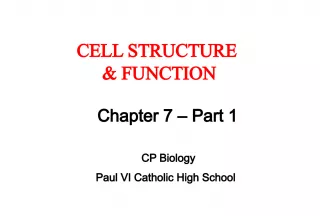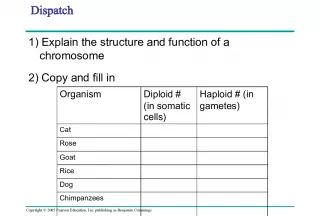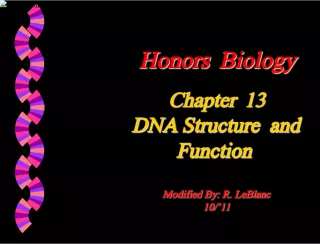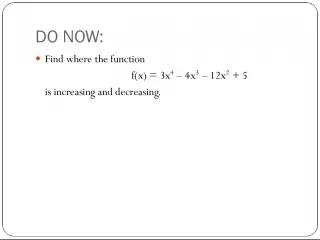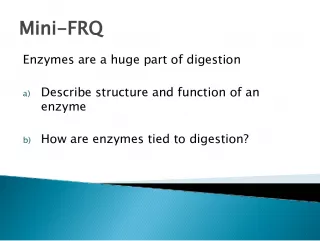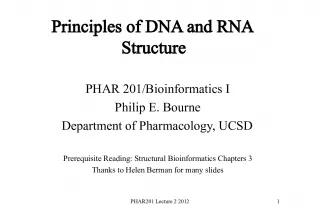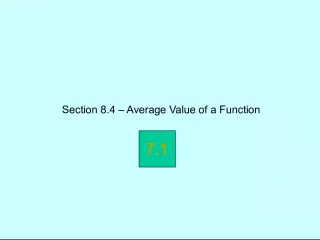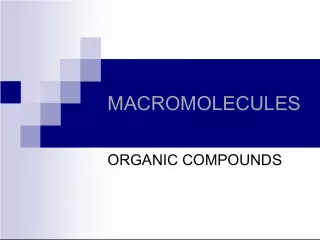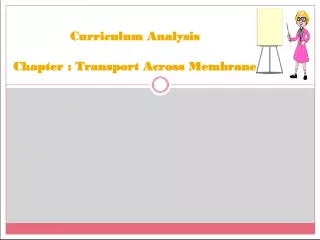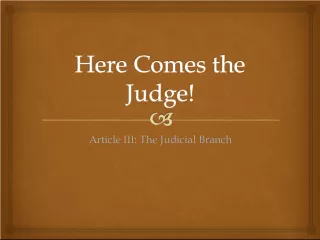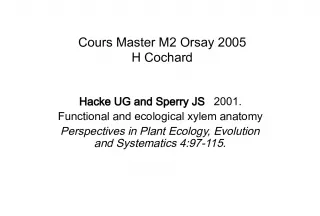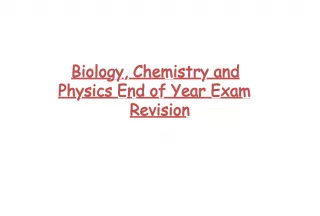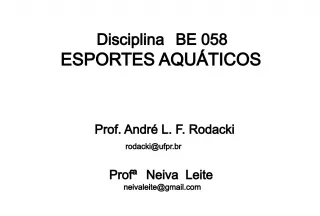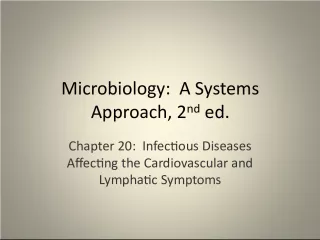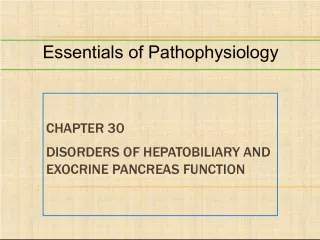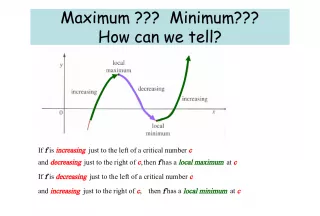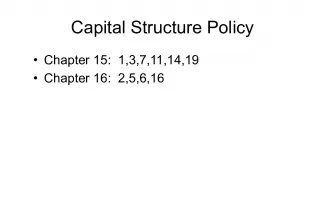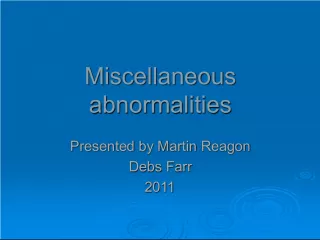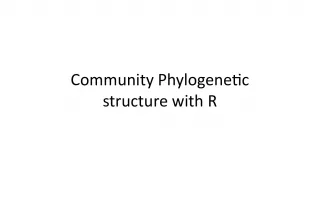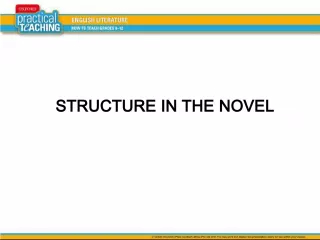The Four Macromolecules: Structure and Function
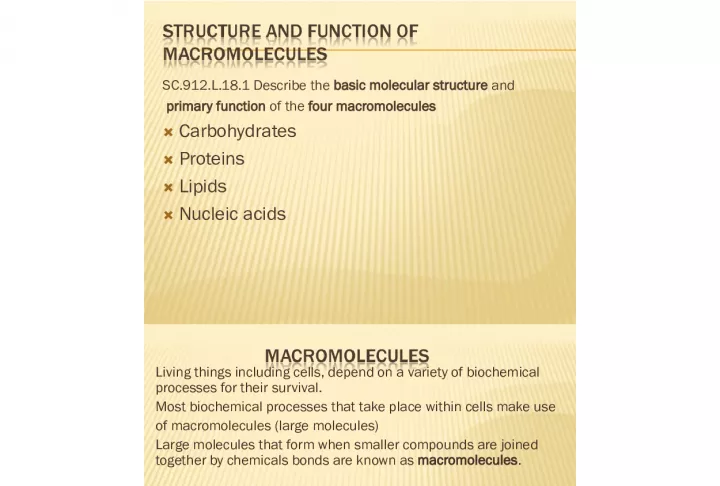

In order for living things and their cells to survive, they rely on a variety of biochemical processes that make use of large molecules called macromolecules. This lesson will focus on four
- Uploaded on | 5 Views
-
 juanita
juanita
About The Four Macromolecules: Structure and Function
PowerPoint presentation about 'The Four Macromolecules: Structure and Function'. This presentation describes the topic on In order for living things and their cells to survive, they rely on a variety of biochemical processes that make use of large molecules called macromolecules. This lesson will focus on four. The key topics included in this slideshow are . Download this presentation absolutely free.
Presentation Transcript
Slide1SC.912.L.18.1 Describe the basic molecular structure and primary function of the four macromolecules Carbohydrates Proteins Lipids Nucleic acids
Slide2living things including cells, depend on a variety of biochemicalprocesses for their survival. Most biochemical processes that take place within cells make use of macromolecules (large molecules) Large molecules that form when smaller compounds are joined together by chemicals bonds are known as macromolecules . Kinds of macromolecules 1. Carbohydrates 2. Proteins 3. Lipids 4. Nucleic acids All these macromolecules are organic compounds. Organic compounds contain chemical bonds between carbon and hydrogen atoms.
Slide33ORGANIC COMPOUNDS ORGANIC COMPOUNDS Compounds CARBON organic Compounds that contain CARBON are called organic . Macromolecules organic molecules Macromolecules are large organic molecules . copyright cmassengale
Slide44CARBON (C) CARBON (C) Carbon 4 electrons Carbon has 4 electrons in outer shell. Carbon covalent bonds 4 Carbon can form covalent bonds with as many as 4 other atoms (elements). C, H, O or N Usually with C, H, O or N . Example: CH 4 (methane) Example: CH 4 (methane) copyright cmassengale
Slide55MACROMOLECULES MACROMOLECULES Large organic molecules. Large organic molecules. POLYMERS Also called POLYMERS . MONOMERS Made up of smaller “building blocks” called MONOMERS . Examples: Examples: 1. Carbohydrates 1. Carbohydrates 2. Lipids 2. Lipids 3. Proteins 3. Proteins 4. Nucleic acids (DNA and RNA) 4. Nucleic acids (DNA and RNA) copyright cmassengale
Slide66QUESTION: HOW ARE MACROMOLECULE S FORMED? QUESTION: HOW ARE MACROMOLECULE S FORMED? copyright cmassengale
Slide77ANSWER: DEHYDRATION SYNTHESIS ANSWER: DEHYDRATION SYNTHESIS polymers monomers “removing water” Forms polymers by combining monomers by “removing water” . HO H HO HO H H H 2 O copyright cmassengale
Slide88QUESTION: HOW ARE MACROMOLECULES SEPARATED OR DIGESTED? QUESTION: HOW ARE MACROMOLECULES SEPARATED OR DIGESTED? copyright cmassengale
Slide99ANSWER: HYDROLYSIS ANSWER: HYDROLYSIS monomers “adding water” Separates monomers by “adding water” HO HO H H HO H H 2 O copyright cmassengale
Slide1010CARBOHYDRATES CARBOHYDRATES Small sugar molecules large sugar molecules Small sugar molecules to large sugar molecules . Saccharide means “sugar” Examples: Examples: A. monosaccharide A. monosaccharide B. disaccharide B. disaccharide C. polysaccharide C. polysaccharide copyright cmassengale
Slide1111CARBOHYDRATES CARBOHYDRATES Monosaccharide: one sugar unit Monosaccharide: one sugar unit Examples: glucose ( Examples: glucose ( C 6 H 12 O 6 ) Fructose Fructose Galactose Galactose glucose glucose copyright cmassengale
Slide1212CARBOHYDRATES CARBOHYDRATES Disaccharide: two sugar unit Disaccharide: two sugar unit Examples: Examples: Sucrose (glucose+fructose) Sucrose (glucose+fructose) Lactose (glucose+galactose) Lactose (glucose+galactose) Maltose (glucose+glucose) Maltose (glucose+glucose) glucose glucose glucose glucose copyright cmassengale
Slide1313CARBOHYDRATES CARBOHYDRATES Polysaccharide: many sugar units Polysaccharide: many sugar units Examples: starch (bread, potatoes) Examples: starch (bread, potatoes) glycogen (found in liver and muscle) glycogen (found in liver and muscle) cellulose (lettuce, corn) cellulose (lettuce, corn) glucose glucose glucose glucose glucose glucose glucose glucose glucose glucose glucose glucose glucose glucose glucose glucose cellulose cellulose copyright cmassengale
Slide14Molecular Structure Carbon Hydrogen Oxygen Ratio 1:2:1 C 6 H 12 O 6 Glucose (Monosaccharide) Sucrose (Disaccharide) Starch (Polysaccharide) Function Primary energy source of most organisms. Energy for cellular respiration Structural support to organisms. For example cellulose in plant’s cell walls.
Slide15Each carbohydrate molecule contains many carbonbonds. Organisms get energy by breaking these Bonds. Carbohydrates provide QUICK Energy, but the energy is USED UP QUICKLY ( short-term energy )
Slide16MacromoleculeComposition Function Carbohydrates Carbon Hydrogen Oxygen (form sugars) Main source of energy for cells Short term energy storage Structural support : cellulose in plant cell’s walls
Slide1717LIPIDS LIPIDS Organic compounds composed of Carbon, Hydrogen and Oxygen not soluble in water General term for compounds which are not soluble in water . Remember: “stores the most energy” Remember: “stores the most energy” Use for long -term energy storage Examples: 1. Fats Examples: 1. Fats 2. Oils 2. Oils 3. Waxes 3. Waxes copyright cmassengale
Slide18Molecular Structure Carbon Hydrogen Oxygen More carbon-hydrogen bonds than carbohydrates and fewer oxygen atoms Do Not dissolve in water Examples: Examples: 1. Fats 1. Fats 2. Oils 2. Oils 3. Waxes 3. Waxes Function 1. Use for long -term energy storage 2. Protection against heat loss (insulation) 2. Protection against heat loss (insulation) 3. Protection against physical shock 3. Protection against physical shock 4. Protection against water loss (waterproof an organism) 4. Protection against water loss (waterproof an organism) 5. Major component of cell membranes (phospholipids) 5. Major component of cell membranes (phospholipids)
Slide1919LIPIDS LIPIDS Triglycerides: c 1 glycerol 3 fatty acids Triglycerides: c omposed of 1 glycerol and 3 fatty acids . H H-C----O H-C----O H-C----O H glycerol O C-CH 2 -CH 2 -CH 2 -CH 2 -CH 2 -CH 2 -CH 2 -CH 2 -CH 2 -CH 3 = fatty acids O C-CH 2 -CH 2 -CH 2 -CH 2 -CH 2 -CH 2 -CH 2 -CH 2 -CH 2 -CH 3 = O C-CH 2 -CH 2 -CH 2 -CH =CH-CH 2 -CH 2 -CH 2 -CH 2 -CH 3 = copyright cmassengale
Slide2020FATTY ACIDS FATTY ACIDS fatty acids There are two kinds of fatty acids you may see these on food labels: 1. Saturated fatty acids: no double bonds (bad) 1. Saturated fatty acids: no double bonds (bad) 2. Unsaturated fatty acids: double bonds (good) 2. Unsaturated fatty acids: double bonds (good) O C-CH 2 -CH 2 -CH 2 -CH 2 -CH 2 -CH 2 -CH 2 -CH 2 -CH 2 -CH 3 = saturated saturated O C-CH 2 -CH 2 -CH 2 -CH =CH-CH 2 -CH 2 -CH 2 -CH 2 - CH 3 = unsaturated copyright cmassengale
Slide21MacromoleculeComposition Function Lipids Carbon Hydrogen Oxygen (form fats, oils and waxes) Use for long -term energy storage I nsulate and waterproof an organism Main substance that makes up biological membranes .
Slide2222PROTEINS PROTEINS Large organic molecules composed of Carbon, Hydrogen, Oxygen and Nitrogen peptide bonds Made of Amino acids (20 different kinds of aa) bonded together by peptide bonds Amino acids contain an amino group (-NH 2 )on one end an carboxyl group (-COOH) on the other end. Amino acids contain an amino group (-NH 2 )on one end an carboxyl group (-COOH) on the other end. Each protein has a characteristic three-dimensional shape. The sequence and arrangement of amino acids determine the shape of the protein and its function in the cell. Each protein has a characteristic three-dimensional shape. The sequence and arrangement of amino acids determine the shape of the protein and its function in the cell. copyright cmassengale
Slide23aa1aa2 aa3 aa4 aa5 aa6 Peptide Bonds Amino Acids (aa)
Slide24Molecular Structure Carbon Hydrogen Oxygen Nitrogen Made of amino acids Peptide bonds hold two amino acids together Function Structural: Serve as the building and connecting material of living things Collagen forms bones, ligaments, tendons etc. Functional: Control the rate of chemical reactions and transport materials. Examples of Functional proteins : Hormones, antibodies ,enzymes . Enzymes control the rate of chemical reaction. Enzymes speed up chemical reactions by decreasing the activation energy
Slide25proteins are worker molecules that are necessary for virtually every activity in your body.
Slide26MacromoleculeComposition Function Proteins (made of amino acids) Carbon Hydrogen Oxygen Nitrogen (form amino Acids) Peptide bonds hold two amino acids together Structural: Serve as the building and connecting material of living things Collagen forms bones, ligaments, tendons etc. Functional: 1. Some control the rate of chemical reactions. Enzymes are proteins that control the rate of chemical reaction. Enzymes decrease the activation energy speeding up chemical reactions 2. Some Transport materials into and out of the cell. Protein carriers on the cell membrane. Hemoglobin transport oxygen. 3. Antibodies are proteins that fight diseases. 4. Hormones carry messenges
Slide27Composed of Carbon, Hydrogen, Oxygen, Nitrogen and Phosphorous Nucleic acids nucleotides Nucleic acids are composed of long chains of nucleotides Nucleotide include: A Nucleotide include: phosphate group phosphate group pentose sugar (5-carbon) pentose sugar (5-carbon) nitrogenous bases: nitrogenous bases: adenine (A) adenine (A) thymine (T) DNA only thymine (T) DNA only uracil (U) RNA only uracil (U) RNA only cytosine (C) cytosine (C) guanine (G) guanine (G)
Slide2828NUCLEOTIDE NUCLEOTIDE O O=P-O O Phosphate Phosphate Group Group N Nitrogenous base Nitrogenous base (A, G, C, or T) (A, G, C, or T) CH2 O C 1 C 4 C 3 C 2 5 Sugar Sugar (deoxyribose) (deoxyribose) copyright cmassengale
Slide2929NUCLEIC ACIDS NUCLEIC ACIDS Two types: Two types: a. Deoxyribonucleic acid (DNA- double helix) a. Deoxyribonucleic acid (DNA- double helix) b. Ribonucleic acid (RNA-single strand) b. Ribonucleic acid (RNA-single strand) Nucleic acids nucleotides. Nucleic acids are composed of long chains of nucleotides. copyright cmassengale
Slide3131DNA - DOUBLE HELIX DNA - DOUBLE HELIX P P P O O O 1 2 3 4 5 5 3 3 5 P P P O O O 1 2 3 4 5 5 3 5 3 G C T A copyright cmassengale
Slide32Molecular Structure Carbon Hydrogen Oxygen Nitrogen Phosphorous Nucleic acids Nucleic acids are nucleotides composed of nucleotides Nucleotide include: A Nucleotide include: phosphate group phosphate group pentose sugar (5-carbon) pentose sugar (5-carbon) a nitrogenous base a nitrogenous base Types DNA and RNA Types DNA and RNA Function 1.Store and transmit information in the form of a code . 2. Genetic information is stored in DNA 3. Information in DNA is then translated by RNA and use to direct the production of proteins .
Slide33MacromoleculeComposition Function Nucleic Acids (made up nucleotides) Carbon Hydrogen Oxygen Nitrogen Phosphorous (form DNA and RNA) Store and transmit information in the form of a code . The most important nucleic acids are DNA and RNA Genetic information is stored in DNA Information in DNA is then translated by RNA and use to direct the production of proteins. SUMMARY OF NUCLEOTIDES
Slide34Carbohydrates, proteins, and lipids can all serve as energy sources for cells . Carbohydrates and proteins yield only four calories per gram. Lipids nine calories per gram. Carbohydrates are the best source of quick energy . Proteins are broken down more slowly than carbohydrates . As a result, proteins are a longer- lasting source of energy. Organisms convert carbohydrates and proteins that are not needed for energy into lipids. Cells store energy in these lipids
Slide35MacromoleculeComposition Function Carbohydrates Carbon Hydrogen Oxygen (form sugars) Main source of energy for cells Short term energy storage Structural support : cellulose in plant cell’s walls Lipids Carbon Hydrogen Oxygen (form fats, oils and waxes) Use for long term energy storage I nsulate and waterproof an organism Main substance that makes up biological membranes .
Slide36MacromoleculeComposition Function Proteins (made of amino acids Carbon Hydrogen Oxygen Nitrogen Peptide bonds hold two amino acids together Structural: Serve as the building and connecting material of living things Collagen forms bones, ligaments, tendons etc. Functional: Play a role in chemical reactions and transport of materials. Hormones, antibodies ,enzymes. Enzymes control the rate of chemical reaction. Enzymes decrease the activation energy speeding up chemical reactions Nucleic Acids Carbon Hydrogen Oxygen Nitrogen Phosphorous (form DNA and RNA) Store and transmit information in the form of a code . The most important nucleic acids are DNA and RNA Genetic information is store in DNA Information in DNA is then translated by RNA and use to direct the production of proteins.
Slide371. Animals breathe in oxygen (O 2 ). This O 2 is used in their bodies in the breakdown of the glucose and fatty acids. The main function of the breakdown of glucose and fatty acids is to provide energy for chemical reactions by producing which of the following? a. enzymes b. deoxyribonucleic acid c. adenosine triphosphate d. proteins
Slide382.What biological macromolecule isgenerally insoluble in water and functions in an important role in biological membranes? a. carbohydrates b. proteins c. nucleic acid d. lipids
Slide393. Proteins are one of four classes ofbiological macromolecules. Which of the following statements about proteins is NOT correct? a. Enzymes are specific types of proteins. b. There are 20 different amino acids that make up proteins. c. All R chains on the amino acids that make up proteins are polar and acidic. d. Peptide bonds form between amino acids in a dehydration reaction, creating proteins
Slide404.Both lipids & carbohydrates are important inthe cell because both a. provide insulation. b. store energy. c. contain nitrogen. d. contain cell walls
Slide415.The diagram below shows two amino acids. What would biochemists call the result of chaining two or more of these molecules together ? a. carbohydrate b. lipid c. nucleic acid d. protein ?
Slide426.Which of the following best describes themajor function of the biological macromolecule DNA? a. provides the energy required by the cell b. synthesizes RNA c. stores information that translates into making proteins d. decreases the activation energy required for a reaction
Slide437. Which answer best describes howcarbohydrates and lipids are similar? a. Both contain fats and oils and have an important structural function within the cell. b. Both are polymers that are linked by peptide bonds. c. Both are nucleic acids involved in making ATP. d. Both contain carbon, hydrogen, and oxygen, and are broken down as a source of energy.
Slide448. Which biological molecule transportssubstances, speeds up reactions, makes hormones, and provides structural support? a. carbohydrates b. proteins c. deoxyribonucleic acid d. adenosine triphosphate
Slide459. Nucleotides consist of a phosphate group, anitrogenous base, and which of the following? a. fatty acids b. an amino acid c. a 5-carbon sugar d. glycerol
